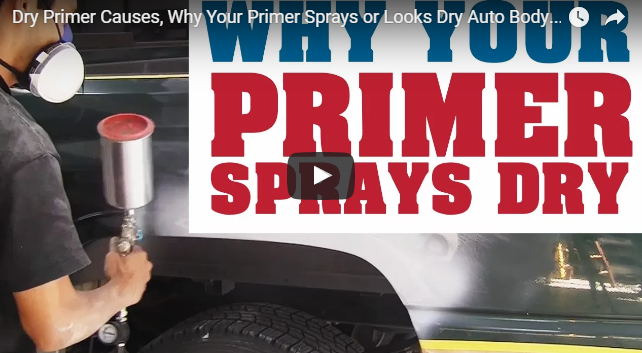Hey, it’s Tony. Thank you for checking out the video and the blog today. We’ll be talking about Dry Primer Causes, Why Your Primer Sprays or Looks Dry Auto Body.
Welcome everybody! What do you think is the most common auto body mistakes that newbies make?
These are some of the mistakes – prepping, sandpaper grits, getting paint mixed up, post-painting mistakes, paint masking, burning paints, etc. I want to go over the most common mistakes and let’s go over some of our questions.
The most common mistake is prepping, but It is the most important part in body work. If you want to have a nice paint job, make sure that your prep is good.
In addition, make sure you prime over feathered areas. If you feathered out some clear coat into your base coat with 320-grit, don’t paint directly over that. You need to seal it and prime it, then block it with 400-grit.
Again, you need to make sure you prime over your bondo areas, your body work and over metal. Never paint single-stage enamel or base coat clear coat over a little metal spot. Otherwise, those little areas will start biting and you’re going to have paint problems.
Another mistake is not sanding with the correct sanding grits. I was speaking with my buddy, Jon Kosmoski, the founder of House of Kolor paints, I asked him what he final sand with. He said he uses 400-grit which is what I always final sand with.
Some people tell me to sand with 600 or 800-grit. The problem with that is you don’t have enough tooth in the sanded prepped area, in your primer, paint or clear coat. There’s not enough sand scuff tooth to put your paint on.
The 400-grit is the perfect sandpaper grit. It’s perfect for primers and even if you’re going over clear coat. You can paint over clear coat directly. It’s the perfect for sealer foundation. You can base right over it if you want to.
And, if you’re sanding with anything finer than 400-grit, you’ll risk blowing your paint right off when you’re going to a car wash or you’re using your pressure washer for your wheel wells.
Orange peel is another common mistake. There are a couple of reasons why you get this. One is paint mixture. Read the back of your can and mix your paint correctly. 99% of the time, the ratio will be 1:1 or 50/50. A pint of base coat to a pint of reducer, which is 16 ounces.
It’s normal to have a little bit of orange peel on your base coat. When it dries, it levels out. But, if you notice too much orange peel on your base coat, thin it out and add 10% reducer.
Reducers come in slow, medium and fast. That is your set time for your paint. If you’re in a hot environment, use a slow reducer to give yourself and the paint a chance to flow out and dry. For colder environment, use a medium reducer. If you’re doing touch-ups in mid temperatures like 75 to 85 degrees, use a fast reducer. It gives your paint time to flow out.
Another reason for orange peel is not having enough pressure when spraying. When spraying base coat, you need 25-28 psi coming out your gun.
When doing clear coat, you want to go at least 30 psi. It’s a nice atomization and getting enough pressure. If you’re using a pretty good spray gun, it’s going to flow out nicely.
The next reason for orange peel is you’re not spraying close enough to your panel. Your need to be about 4-7 inches away from your panel. The closer you are to your panel, the faster you’re going to have to move because it’s laying on real quick. The farther you are, the more fan pattern you get, and you get to move a little bit slower.
Remember when you’re painting, hold your gun even with the panel and do a 50% overlay. Use the light to see that it’s coming on glossy. If not, give it another pass. You don’t have to worry about too much overloading when you’re on flat surfaces, unlike when you’re on your side like doing doors, fenders and quarter panels where you have to worry about runs.
Then again, it’s always better to have a run than dry, in my opinion, because you can sand out and buff a run.
All of these things are shown in the LearnAutoBodyAndPaint VIP Program, so go check out what’s in store for you in VIP.
IF you’re a newbie on auto body work, grab your FREE 85-Page Auto Body And Paint Manual. You’ll start learning more to work on your car projects.
Please Like, Share and Subscribe to my videos. Thank you so much! Talk soon! Cheers!
Tony
Other Helpful Links:
Check out LearnAutoBodyAndPaint VIP to learn more about painting tips and strategies!
I’m Back in The SHOP! What’s Up? – DIY Auto Body for Newbies
Wet Sand & Dry Sanding Techniques When Prepping for Base Coat Painting
How To Paint a Car With Single Stage Enamel Paint
The Basics of Painting A Car From Home!
Avoid This Polyester Primer Mistake – Complete DIY Auto Body Paint Project Update

I tried to get into the vip & can’t get in .Tried to reset but dose not recognize my email address .
I have fwd this to support, they should have gotten to you by now if you opened a ticket.